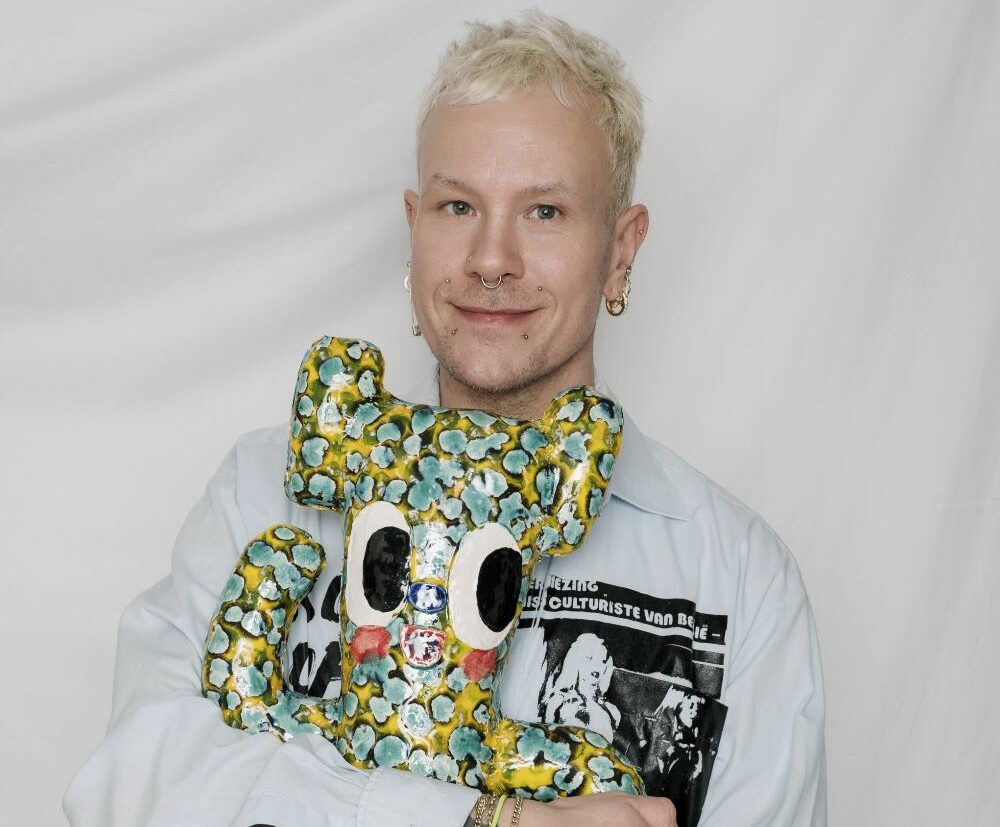Artist Bas Kosters on the serious business of creating joy
Lauren Comiteau
With his new exhibition, An exercise in JOY showing at Zaandam’s Artzaanstad, former fashion designer turned artist Bas Kosters comes full circle.
Bas Kosters was once famous as the bad boy of the Dutch fashion scene. Born in 1977 and raised in the small Dutch city of Zutphen, Kosters twice opened Amsterdam Fashion Week before giving it all up in 2018 to become a full-fledged artist.
“I had the feeling that I could not express my creativity within that medium anymore, although I always took a totally open approach to create beautiful, expressive fashion shows with video art and performance music,” Kosters said in his colourful—and yes, joyful—studio on the bustling KNSM-plein as he put the final touches on his years-in-the-making JOY exhibition.
“When choosing to take this new direction, I was kind of insecure. People know you as that designer. Is this really gonna work? But currently we are working on a large retrospective exhibition of my art for next year. So, it paid off, and I’m happy I made that choice.”
An exercise in JOY
Kosters’ new JOY exhibit includes his signature colourful and quirky tapestries, wearable art, paintings and ceramics. But the star of the show is Jobe, a “gender fluid” teddy bear Kosters created specifically for this exhibit and whose likeness appears on many of its mediums—from postcards and t-shirts to ceramics and ink drawings.
“I’ve always been crazy about toys and dolls and puppets, and I just became crazy about bears,” he said. “I think the teddy bear is a metaphor and I was looking for the reason. In the context of joy, you give a bear to somebody you care for. It’s so joyful and so personal. And I wanted to talk about that in my work.”
Finding joy has been a sometimes difficult journey for Kosters. After losing both of his parents a decade ago, he got sober during what he called a “life-changing moment”.
Sober living proved healthier, but Kosters said he missed the “thrill-of-joy experience” and had trouble finding his “mojo”. He decided to try to live more in the moment, to be more thankful, he said, for the joy in his life.
“So I thought, why not try to see if this is something I can evoke by tackling the subject head on? And I realized joy is something you can manifest, but you must put in the work,” he said. “Joy is serious business.”
Inspiration
Although the teddy was the inspiration for his current exhibition, Kosters found inspiration in his teenage years from visually arresting, outspoken artists like Nina Hagan, Deee-Lite and the B-52s. “I was always interested in visual identity, and I loved drawing. And that led me to a career in creative expression.”
By his mid-teens, he realized he wanted to go to art school, and by age 20, he decided to study fashion. But this eclectic creative was always interested in illustration, fabrics and patterns. When he graduated, he even had a performance band.
“There’s a clear visual language in all the things I find inspiring, a graphic notion,” he said. “I love text, so I love advertisements. But I also love low culture. I love the photo prints of meat on Turkish supermarket windows. I love traffic cones and roadblocks. I love cafeteria shop windows. I love visual imagery, but also visual irritation, a kind of a disturbance—not disturbance in a bad way, but just something out of the ordinary.”
The same is true for Amsterdam, he said, the city he’s called home for decades. “It’s beautiful, but I get more excited about running into a pile of garbage than looking at a canal house. I like interference in the daily order, and that’s what I do with my work. It’s some kind of hiccup, some kind of way to arouse or make friction, not negatively, just friction that causes attention.”
From Zutphen to Amsterdam
Growing up in Zutphen with two brothers and supportive parents, Kosters said he didn’t really fit in, but he also wasn’t an outsider. “I was just that chubby kind of weird guy. Queer, of course. I came out when I was 15. I always had friends, mostly girlfriends. I was bullied a bit, but not really. Sometimes it was difficult, but I never wanted to be like the others. I did not want to conform.”
By the time he was headlining Amsterdam Fashion Week, he was still a non-conformist. Known as the fashion world’s enfant terrible, he hosted anti-fashion parties featuring such entertainment as nude performers and a runway of garbage bags.
“Although I might have done really rebellious things, they were always done from a vision of engagement,” he said. “So even throwing anti-fashion parties, we did it to talk about the narrow-mindedness of the commercial world. We were trying to open a playful space for creation, music, nightlife, fashion and performance art. This anti-fashion party was just really a kick in the butt of the system.”
Indeed, Kosters’ art is often about accessibility—whether letting people rent it from Artzaanstad or designing an affordable pair of knickers for the Dutch chain Zeemans.
Reflecting on his career to date, Kosters said he’s grateful for the opportunities he’s had, although he wouldn’t mind expanding his horizons. “I sometimes wish for more international success, because I’m quite well known in the Netherlands with certain generations of people,” he said. “But I just try to be grateful. Anything can happen, right? I’m still young.”
An exercise in JOY is showing at Zaandam’s Artzaanstad up to July 6. See website for more details.
Thank you for donating to DutchNews.nl.
We could not provide the Dutch News service, and keep it free of charge, without the generous support of our readers. Your donations allow us to report on issues you tell us matter, and provide you with a summary of the most important Dutch news each day.
Make a donation